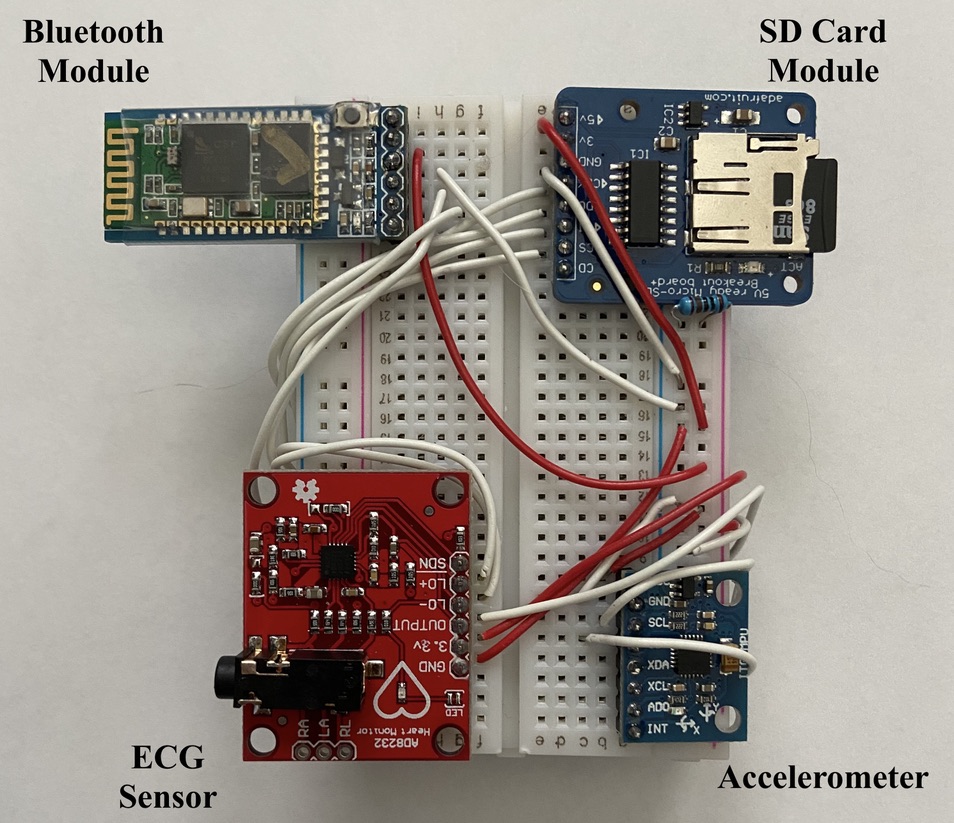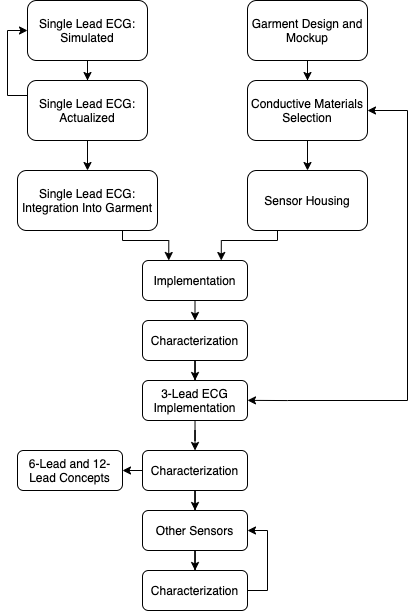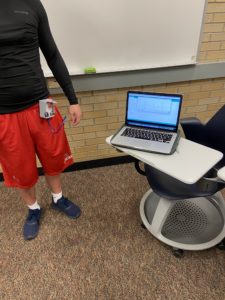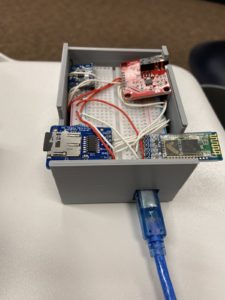ECG Enabled Smart Garment
Overview
Diagnosing and monitoring heart irregularities in patients is challenging, especially with the escalation of risk factors characteristic of older people. To achieve accurate heart diagnostics in patients today, ECG (electrocardiogram) systems are commonly used by health professionals. However, in the current state of ECG technology, cardiac patients must stay in a hospital for an extended period while undergoing continuous monitoring by medical practitioners. This commitment is a heavy strain on both hospital resources and the patient who must suspend their life to receive care in the hospital. To solve this problem, our team has explored the feasibility of a smart shirt capable of continuously monitoring ECG signals. Our proposed solution circumvents hospitalization by tracking the ECG data of a patient while they can continue their daily activities. This proposed solution would reduce the strain on a hospital by leaving rooms unoccupied and would provide staff with a much quicker, remote way to monitor a cardiac patient. While mobile solutions to ECG monitoring already exist, they are bulky and intended for short periods of use throughout the day. The team created a prototype smart garment that is meant to be worn as a comfortable, everyday shirt with the added functionality of accurate ECG data.

Live Zoom Chat
Use the link below to join us live from 8:00 – 10:30 a.m. on December 3.
Please use passcode: NA
Or iPhone one-tap: 16699006833,99784263559# or 12532158782,99784263559#
Or Telephone:
Dial: +1 669 900 6833 (US Toll) or +1 253 215 8782 (US Toll)
Meeting ID: 997 8426 3559
Team Members
- Jamie Stokes
- Nick Gonzales
- Remha Yohannes
- Ilana Kitterman
The Client
- Physia
Acknowledgements
Project Advisor: Tony Vandenberge
Technical Advisor: Dr. Jeff Schowalter, Dr. Michael Wakin
Video
Design Approach
The main goal for our team was to test the feasibility of an ECG enabled smart garment and gather experiential data to construct a wearable prototype and make recommendations for our client, Physia. Because our design was dependent on the data collected, our design approach was constantly changing. Initially, our team divided into two subsystems: mechanical and electrical. The mechanical team worked on constructing a garment mockup and prototype housing while the electrical team developed a single lead ECG system to take ECG readings.
In the initial design approach, our team planned to explore and characterize a variety of different sensors. However, due to the success of the ECG signal acquisition, we shifted our focus towards the characterization and development of a more comprehensive ECG system. In our new approach, we characterized many different aspects of taking ECG readings.
We ran experiments with different variables to determine what we should include in our final prototype. Based on our experimentation, our areas of interest were signal characterization, accelerometer data, data storage, and wireless transmission. The tests we conducted to facilitate this design process were:
- Collect ECG data
- Test different ECG wires
- Test different ECG boards
- Stabilize wires
- Gather motion-sensing data with an accelerometer
- Store ECG and motion data onto an SD card
- Transmit and visualize ECG data over Wi-Fi with a web server
- Transmit and visualize ECG data over Wi-Fi with the User Datagram Protocol (UDP)
- Transmit and visualize ECG data with Bluetooth

Design Solution
 Our final design solution includes an ECG enabled smart garment prototype along with a detailed analysis of data collected to facilitate future design iterations. This type of garment promotes heart health by continuously storing and transmitting a patient’s ECG data, allowing heart problems to be spotted early on. The smart garment prototype includes a shirt with integrated ECG wires and a portable electronic smart hub to collect and transmit sensor data. The ECG wires in the garment are connected to the smart hub with a 3.5 mm jack. The hub contains a small breadboard with electronics to collect and transmit ECG and motion data, housed in a 3D printed enclosure.
Our final design solution includes an ECG enabled smart garment prototype along with a detailed analysis of data collected to facilitate future design iterations. This type of garment promotes heart health by continuously storing and transmitting a patient’s ECG data, allowing heart problems to be spotted early on. The smart garment prototype includes a shirt with integrated ECG wires and a portable electronic smart hub to collect and transmit sensor data. The ECG wires in the garment are connected to the smart hub with a 3.5 mm jack. The hub contains a small breadboard with electronics to collect and transmit ECG and motion data, housed in a 3D printed enclosure.
The hub collects ECG data using a single lead analog ECG sensor. This sensor sends an analog ECG signal to an Arduino Uno microcontroller, which acts as the brains of the electronic smart hub. The data is stored alongside motion data collected by an accelerometer onto an onboard SD card. The ECG data is also transmitted via Bluetooth to a computer, where it can be plotted and visualized in real-time.
Besides the prototype itself, our design solution also includes an analysis of data collected.
Our team explored the functionality of various forms of wireless transmission, data plotting, and different types of ECG boards.
In addition, we looked into different methods of reducing motion artifacts, or noise in the ECG signal caused by motion. We determined that a method of filtering called adaptive filtering could be very useful to reduce motion artifacts. This method of filtering involves using motion data from the user to get rid of unwanted noise, which is why the accelerometer (aka motion sensor) was added.
Next Steps

Our team was successful in having the ECG data sent via Bluetooth to a computer and sending data via Wi-Fi. The Bluetooth data can be plotted in real-time allowing the ECG signal to be visualized. ECG data sent over wifi is still real-time but the plot tends to have a major time delay.
- Long term, Wi-Fi is preferable to Bluetooth because Bluetooth has a limited range
- Wi-Fi can send data whenever there is a Wi-Fi signal, meaning that Wi-Fi has a much greater range than Bluetooth
For future work, the client can decide whether to stick with Bluetooth or use Wi-Fi. The data is still sent in real-time over Wi-Fi and through some clever coding, the data can also be plotted in real-time.
Because the final project was a proof of concept, we believe that we have been successful in developing an ECG shirt that shows the future of smart garment technology. The client must decide whether or not to make the final product medical grade. This means making the shirt FDA and CE approved.
- By having an FDA and CE-approved ECG sensing shirt the product can be employed by medical practices to make readings and diagnose patients
- The product would be more desirable than a non-medical grade shirt but comes at the cost of increased difficulty and legal issues
The client can also choose to take the route similar to apple watches which aren’t medical-grade but still show useful health information that can lead the patient to go to a hospital to get diagnosed. 
Another opportunity for future work on the shirt involves the use of non-stick leads, instead of the current use of stick-on leads.
- Would allow for a much more comfortable user experience
- Non-stick leads that can read ECG data as effectively as sticky leads do exist at the moment.
Since the current shirt prototype has three leads, the client can choose to design a shirt to have more leads.
- Would give a more robust readout of the patient but also has an increase of difficulty for implementation
- By switching out the single-lead ECG chip on our proof of concept for a higher-order ECG board the number of leads can be increased
Meet the Team
Jamie Stokes
 I’m an Electrical Engineer graduating in Fall 2020. I like playing hockey, cooking, and making ECG enabled smart garment.
I’m an Electrical Engineer graduating in Fall 2020. I like playing hockey, cooking, and making ECG enabled smart garment.
Nick Gonzales
 I am a senior student studying electrical engineering with a focus on integrated circuits and electronics. I will be graduating in December and begin working in the semiconductor industry. I also enjoy tinkering with Arduino and Raspberry pi projects in my free time.
I am a senior student studying electrical engineering with a focus on integrated circuits and electronics. I will be graduating in December and begin working in the semiconductor industry. I also enjoy tinkering with Arduino and Raspberry pi projects in my free time.
Ilana Kitterman
 Hi, I’m Ilana! I am a senior in Mechanical Engineering graduating in December 2020. I have always been passionate about helping others and have found a love for innovative engineering through product development. I hope to find myself in an engineering position in the future where I can apply my engineering skills towards the benefit of society.
Hi, I’m Ilana! I am a senior in Mechanical Engineering graduating in December 2020. I have always been passionate about helping others and have found a love for innovative engineering through product development. I hope to find myself in an engineering position in the future where I can apply my engineering skills towards the benefit of society.
Remha Yohannes
 I’m Remha Yohannes and I’m a graduating senior in Mechanical Engineering. I’m planning to come back in the spring for grad school. I’m hoping to go into aerospace or manufacturing once I graduate. Once I’m in the industry for a couple of years, I intend to start my own business.
I’m Remha Yohannes and I’m a graduating senior in Mechanical Engineering. I’m planning to come back in the spring for grad school. I’m hoping to go into aerospace or manufacturing once I graduate. Once I’m in the industry for a couple of years, I intend to start my own business.
